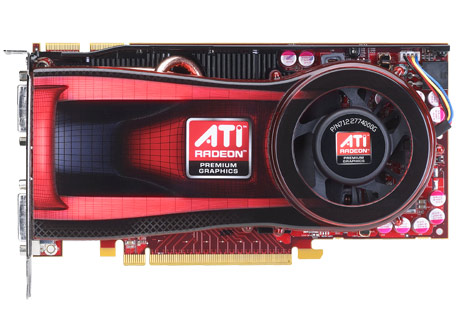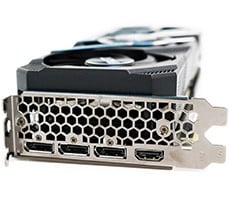
AMD is launching yet another new ATI Radeon graphics card today. And in light of the current worldwide economic conditions, along with the performance and power consumption data we'll be presenting you on the proceeding pages, we suspect it's going to be a welcomed addition to the company's already potent graphics card line-up.
You see, the brand new Radeon HD 4770 is AMD's first mainstream desktop GPU manufactured using a 40nm process, and as such, it is more economical for the company to produce (with a smaller die size) and it consumes little power relative to the current crop of products manufactured at 55nm. The Radeon HD 4770's main features don't stray far from the other members of the Radeon HD 4000 family, but its specifications are somewhat different due to the use of a new GPU, which was formerly codenamed RV740.
Now then, what if we told you this new lower power GPU also drops in at a miserly $99 price point? Are the days of the reasonably powerful $99 graphics card back, you ask? We'll answer that question for you in the pages ahead but in the mean time, the Radeon HD 4770's main features and benefits are listed below for those of you who like to see all of the gritty details. We'll discuss the card itself and its overall performance a little later. Take a look...

ATI Radeon HD 4770
|

|
|
AMD ATI Radeon HD 4770 |
|
Specifications and Features | |
- 826 million transistors on 40nm fabrication process
- PCI Express 2.0 x16 bus interface
- GDDR5 memory
- MicrosoftDirectX 10.1 support
- Shader Model 4.1
- 32-bit floating point texture filtering
- Indexed cube map arrays
- Independent blend modes per render target
- Pixel coverage sample masking
- Read/write multi-sample surfaces with shaders
- Gather4 texture fetching
- Unified Superscalar Shader Architecture
- 640 stream processing units
- Dynamic load balancing and resource allocation for vertex, geometry, and pixel shaders
- Common instruction set and texture unit access supported for all types of shaders
- Dedicated branch execution units and texture address processors
- 128-bit floating point precision for all operations
- Command processor for reduced CPU overhead
- Shader instructionUp to 128 texture fetches per clock cycle
- Up to 128 textures per pixel
- Fully associative multi-level texture cache design
- DXTC and 3Dc+ texture compression
- High resolution texture support (up to 8192 x 8192)
- Fully associative texture Z/stencil cache designs
- Double-sided hierarchical Z/stencil buffer
- Early Z test and Fast Z Clear
- Lossless Z & stencil compression (up to 128:1)
- Lossless color compression (up to 8:1)
- Up to 8 render targets (MRTs) with anti-aliasing
- Accelerated physics processing
- Dynamic Geometry Acceleration
- High performance vertex cache
- Programmable tessellation unit
- Accelerated geometry shader path for geometry amplification
- Memory read/write cache for improved stream output performance
- Anti-aliasing features
- Multi-sample anti-aliasing (2, 4, or 8 samples per pixel) and constant caches
- Up to 24x Custom Filter Anti-Aliasing (CFAA)
- Adaptive super-sampling and multi-sampling
- Gamma correct
- Super AA (ATI CrossFireX configurations only7)
- All anti-aliasing features compatible with HDR rendering
- Texture filtering features
- 2x/4x/8x/16x high quality adaptive anisotropic filtering modes (up to 128 taps per pixel)
- 128-bit floating point HDR texture filtering
- sRGB filtering (gamma/degamma)
- Percentage Closer Filtering (PCF)
- Depth & stencil texture (DST) format support
- Shared exponent HDR (RGBE 9:9:9:5) texture format support
- OpenGL 3.0 support
|
ATI Avivo HD Video and Display Platform
- Unified Video Decoder (UVD) for H.264/AVC, VC-1, and MPEG-2 video formats
- High definition (HD) playback of Blu-ray and HD DVD video
- Dual stream (HD+SD) playback support
- DirectX Video Acceleration 1.0 & 2.0 support
- Support for BD-Live certified applications
- Hardware DivX and MPEG-1 video decode acceleration
- ATI Avivo HD Video Post Processor1
- Color space conversion
- Chroma subsampling format conversion
- Horizontal and vertical scaling
- Gamma correction
- Advanced vector adaptive per-pixel de-interlacing
- De-blocking and noise reduction filtering
- Detail enhancement
- Color vibrance and flesh tone correction
- Inverse telecine (2:2 and 3:2 pull-down correction)
- Bad edit correction
- Enhanced DVD upscaling (SD to HD)
- Automatic dynamic contrast adjustment
Two independent display controllers
- Drive two displays simultaneously with independent resolutions, refresh rates, color controls and video overlays for each display
- Full 30-bit display processing
- Programmable piecewise linear gamma correction, color correction, and color space conversion
- Spatial/temporal dithering provides 30-bit color quality on 24-bit and 18-bit displays
- High quality pre- and post-scaling engines, with underscan support for all display outputs
- Content-adaptive de-flicker filtering for interlaced displays
- Fast, glitch-free mode switching
- Hardware cursor
- Two integrated dual-link DVI display outputs
- Each supports 18, 24, and 30-bit digital displays at all resolutions up to 1920x1200 (single-link DVI) or 2560x1600 (dual-link DVI)3
- Each includes a dual-link HDCP encoder with on-chip key storage for high resolution playback of protected content4
- Two integrated 400 MHz 30-bit RAMDACs
- Each supports analog displays connected by VGA at all resolutions up to 2048x15363
- DisplayPort output support
- 24- and 30-bit displays at all resolutions up to 2560x16003
- HDMI output support
- All display resolutions up to 1920x1080
- Integrated HD audio controller with support for stereo and multi-channel (up to 7.1) audio formats, including AC-3, AAC, DTS5, enabling a plug-and-play audio solution over HDMI
- Integrated AMD Xilleon HDTV encoder
- Provides high quality analog TV output (component/S-video/composite)
- Supports SDTV and HDTV resolutions
- Underscan and overscan compensation
- Seamless integration of pixel shaders with video in real time
- VGA mode support on all display outputs
ATI PowerPlay technology
- Advanced power management technology for optimal performance and power savings
- Performance-on-Demand
- Constantly monitors GPU activity, dynamically adjusting clocks and voltage based on user scenario
- Clock and memory speed throttling
- Voltage switching
- Dynamic clock gating
- Central thermal management – on-chip sensor monitors GPU temperature and triggers thermal actions as required
ATI CrossFireX Multi-GPU Technology
- Scale up rendering performance and image quality with up to two GPUs
- Integrated compositing engine
- High performance dual channel bridge interconnect
 
ATI Radeon HD 4770 Technical Details and Product Matrix
As the slides above show, the new $99 Radeon HD 4770 falls somewhere in between the Radeon HD 4670 and Radeon HD 4850 in AMD's current product line-up. The 40nm RV740 GPU at the heart of the card consists of 826M transistors and its reference specifications call for a 750MHz GPU clock. The GPU is outfitted with 640 stream processors, 32 texture units, and 16 ROPs and it is linked to its 512MB GDDR5 frame buffer through a 128-bit interface running at 800MHz. At its reference clock speeds, the Radeon HD 4770 offers peak texture and pixel fillrates of 24GTexel/s and 12GPixel/s, respectively, with 51.2GB/s of memory bandwidth. Maximum board power is rated at 80W, which puts it just over the limit of a PCI Express x16 graphics slot, hence the card requires a single 6-pin PCI Express supplemental power connector. Let's drop down to have a closer look next.
|









